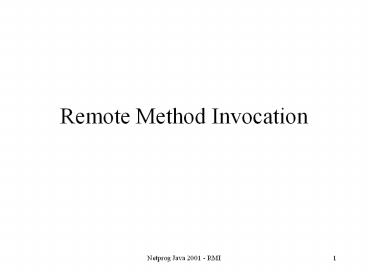Remote Method Invocation - PowerPoint PPT Presentation
1 / 17
Title: Remote Method Invocation
1
Remote Method Invocation
2
Network Programming Paradigms
- Sockets programming design a protocol first,
then implement clients and servers that support
the protocol. - RMI Develop an application, then move some
objects to remote machines. - Not concerned with the details of the actual
communication between processes everything is
just method calls.
3
Call Semantics
- Method Call Semantics what does it mean to make
a call to a method? - How many times is the method run?
- How do we know the method ran at all?
- RMI does a great job of providing natural call
semantics for remote objects/methods. - Simply a few additional Exceptions that you need
to handle.
4
Finding Remote Objects
- It would be awkward if we needed to include a
hostname, port and protocol with every remote
method invocation. - RMI provides a Naming Service through the RMI
Registry that simplifies how programs specify the
location of remote objects. - This naming service is a JDK utility called
rmiregistry that runs at a well known address (by
default).
5
RMI Adds a few layers
Server App.
Client App.
Skeleton
Stubs
Remote Reference
Remote Reference
Transport
Transport
6
Remote Object References
- The client acquired a reference to a remote
object. - This part is different from creating a local
object. - The client calls methods on the remote object
- No (syntactic) difference!
- Just need to worry about a few new exceptions.
7
Overview of RMI Programming
- Define an interface that declares the methods
that will be available remotely. - The server program must include a class the
implements this interface. - The server program must create a remote object
and register it with the naming service. - The client program creates a remote object by
asking the naming service for an object
reference.
8
Server Details extending Remote
- Create an interface the extends the Remote
interface. - This new interface includes all the public
methods that will be available as remote methods. - public interface MyRemote extends Remote
- public int foo(int x) throws RemoteException
- public String blah(int y) throws
RemoteException - . . .
9
Server Details Implementation Class
- Create a class that implements the interface.
- The class should also extend UnicastRemoteObject
- This class needs a constructor that throws
RemoteException ! - This class is now used by rmic to create the stub
and skeleton code.
It doesnt have to extend UnicastRemoteObject,
there is another way
10
Remote Object Implementation Class
- public class MyRemoteImpl extends
UnicastRemoteObject implements MyRemote - public MyRemoteImpl() throws RemoteException
- public int foo(int x)
- return(x1)
- public String blah(int y)
- return(Your number is y)
11
Generating stubs and skeleton
- Compile the remote interface and implementation
- gt javac MyRemote.java MyRemoteImpl.java
- Use rmic to generate MyRemoteImpl_stub.class,
MyRemoteImpl_skel.class - gt rmic MyRemoteImpl
12
Server Detail main()
- The server main() needs to
- create a remote object.
- register the object with the Naming service.
- public static void main(String args)
- try
- MyRemoteImpl r new MyRemoteImpl()
- Naming.bind(joe,r)
- catch (RemoteException e)
- . . .
13
Client Details
- The client needs to ask the naming service for a
reference to a remote object. - The client needs to know the hostname or IP
address of the machine running the server. - The client needs to know the name of the remote
object. - The naming service uses URLs to identify remote
objects.
14
Using The Naming service
- Naming.lookup() method takes a string parameter
that holds a URL indicating the remote object to
lookup. - rmi//hostname/objectname
- Naming.lookup() returns an Object!
- Naming.lookup() can throw
- RemoteException
- MalformedURLException
15
Getting a Remote Object
- try
- Object o naming.lookup(uri//monica.cs.rpi
.edu/joe) - MyRemote r (MyRemote) o
- . . . Use r like any other Java object! . . .
- catch (RemoteException re)
- . . .
- catch (MalformedURLException up)
- throw up
16
Starting the Server
- First you need to run the Naming service server
- start rmiregistry
- Now run the server
- java ServerMain
17
Sample Code
- There is sample RMI code on the course homepage
- SimpleRMI remote integer arithmetic
- AlternativeSimpleRMI Implementation class
doesnt extend UnicastRemoteobject - RemoteSort remote sort server uses Java List
objects

